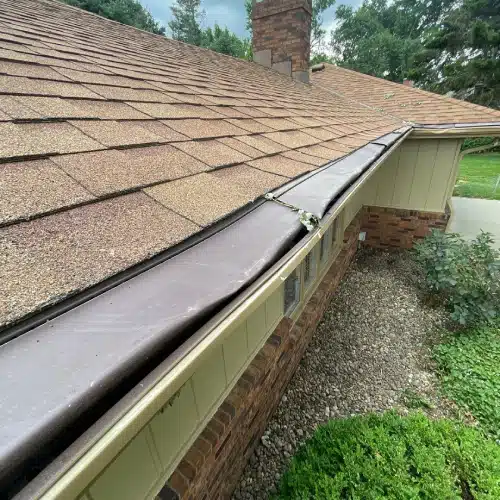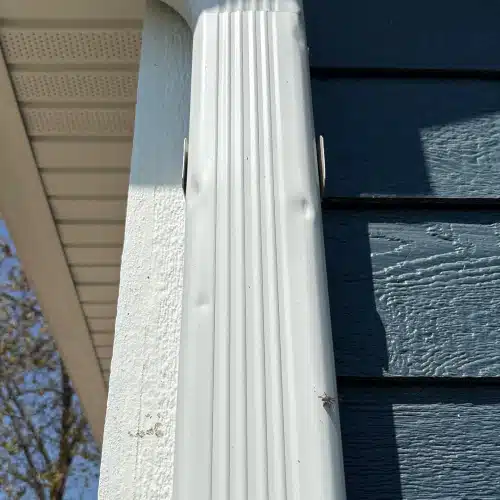How Storms Cause Roof Damage and How Homeowners Should Prepare
Thunderstorms can bring high winds, hail, and lightning—all of which pose serious risks to your roof, siding, and safety. For Omaha homeowners to protect their homes from damage and stay safe, it’s important to understand how storms cause roof and exterior damage in the first place.
In this guide, the storm damage repair experts at Anchor Roofing explain what causes thunderstorms, the damage they can do, and how to prepare and respond as a homeowner.
How Do Thunderstorms Form?
In brief, thunderstorms occur when warm, moist air rises to meet cooler air in the atmosphere. This rising air cools and condenses into cumulonimbus clouds, which are the classic towering clouds associated with thunderstorms.
These conditions of moisture and lifting air, along with atmospheric instability, can continue to intensify, resulting in strong winds, heavy rain, and lightning—the classic signs of a thunderstorm.
How Often Do Thunderstorms Happen in Omaha?
Here in Omaha, we see anywhere from 40–60 thunderstorm days per year—a bit higher than the national average. As seasoned Omaha roofers can tell you, the busiest time of year for thunderstorms begins in April and ends around August (though, of course, storms may strike outside of these times.
In Omaha and throughout the Great Plains, conditions are often ideal for thunderstorm formation. The intermingling of cold fronts and drylines along with warm, moist air during the spring and summer, creates the perfect conditions for thunderstorms.
How Do Storms Cause Roof Damage?
Depending on the type and strength of the storm, thunderstorms can cause roof damage in a variety of ways, including:
- Hail – Hail is the classic “storm damage” culprit. Falling chunks of ice can cause bruising at best and crack or dislodge shingles at worst, leaving roofs severely compromised.
- High winds – Winds reaching speeds of 50–60 mph are considered damaging. High winds can blow off shingles, break tree limbs, and fling debris against your home.
- Lightning – While rare, lightning can strike homes and cause severe damage and fires. Lightning may also damage your home by causing power surges.
- Heavy rain – Rain is not typically a direct source of damage—but if your roof is vulnerable, heavy rain can penetrate the surface of your roof and create underlying structural issues, leaks, and more.
- Tornadoes – Tornadoes, of course, can devastate or completely destroy homes unfortunate enough to be in their path.
Storm damage doesn’t always appear severe immediately, and many homeowners don’t realize how storms cause roof damage until it’s too late. Leaving even minor damage unaddressed can lead to major repairs or a premature roof replacement down the line.


Thunderstorm Safety Tips
If storm season is approaching or thunderstorms are predicted in your area, homeowners should take steps to protect themselves, their family, and their home, including:
- Keep gutters and downspouts clear before storm season
- Trim overhanging branches
- Bring lawn ornaments, furniture, and other objects indoors
- Stay indoors and away from windows during storms
- Unplug electronics to protect them from surges
- Don’t attempt roof inspections yourself—call a pro
What Should You Do After a Thunderstorm?
Following a severe thunderstorm, homeowners should prioritize ensuring their home and roof are still in good condition. Important steps to take include:
- Completing a visual inspection of your home by walking its perimeter and surveying your roof, siding, gutters, and other areas for damage
- Taking photos of any signs of damage you find
- Scheduling a professional inspection to assess the condition of your roof—most roofers (like Anchor Roofing) will offer this service for free
- Contact your insurance provider if damage is identified
Impacted by Storm Damage? Here’s When to Call a Professional
As you complete your visual survey of your home, look for signs of storm damage such as cracked or missing shingles, dents in gutters and siding, or excessive asphalt granules near downspouts or on the ground near your roofline.
In addition, check weather reports—if large hail or damaging winds were reported in your area, it’s a good idea to schedule an inspection as a precaution.
At Anchor Roofing, our team provides thorough storm damage inspections with absolutely no obligation necessary. Whether your home was damaged or not, we’ll provide a full rundown of the condition of your roof, providing you with total peace of mind. Book your inspection today!
